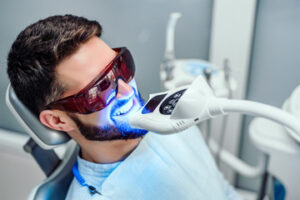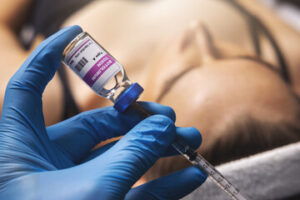Teeth whitening involves applying a bleaching agent to the teeth. Depending on the type of product used, it can be done at home or in a dentist’s office.
The most common side effects are tooth sensitivity and irritation of the soft tissues in the mouth. These are usually temporary and should disappear a few days after the treatment ends. Click Here to learn more.
There are several ways to whiten teeth, from professional whitening treatments at your dentist’s office to over-the-counter products and at-home remedies. Regardless of which type of teeth whitening method you choose, it’s important to follow the directions to avoid damage to your enamel and ensure safe whitening results.
It’s also important to know what type of stains you’re dealing with and which type of whitening product might be best suited for them. For example, more severe or complex stains might be better lightened by another technique such as veneers or bonding rather than bleaching.
Over-the-counter whitening treatments typically use peroxide to bleach stains from the surface of your teeth. Peroxide is available in a variety of formats such as trays, strips, gels, and even pens. A common ingredient in whitening gels is carbamide peroxide which breaks down the complex molecules that make your teeth look discolored. You can also find hydrogen peroxide in whitening treatments which works by reducing the pH level of your tooth enamel.
The most important thing to remember is to avoid consuming anything acidic or hard after a whitening treatment. Acidic foods can weaken your enamel, and hard foods can etch or damage the surface of your teeth. Additionally, it’s a good idea to brush your teeth after each meal or snack so that any food particles and debris are removed before they can stain your enamel.
When it comes to at-home whitening kits, look for one that has earned the ADA Seal of Acceptance to ensure its safety and efficacy. In addition, look for a kit that allows you to customize the mouthpiece to fit your mouth and mouth shape. This will allow for a more comfortable experience and reduce the risk of irritation.
When it comes to your smile, there’s no such thing as being too careful! Teeth whitening is an excellent way to brighten your smile and improve your self-confidence. However, it’s also important to remember that whiter teeth don’t necessarily equal healthier teeth. For this reason, it’s essential to visit your dentist regularly to monitor your dental health and make sure that any problems are addressed promptly and effectively.
It’s Effective
Teeth whitening is one of the most common dental procedures, and for good reason: it’s a quick and relatively inexpensive way to make your smile look brighter and more appealing. Whitening is available in dental offices and at home, and it uses a chemical called peroxide to bleach or whiten the teeth.
A good teeth whitening regimen should lighten the natural tooth color by 1 to 2 shades. However, the color change is temporary, as any new food or beverage will stain the teeth again.
There are many different types of whitening products available, including gels, strips, rinses, and trays. Each type works differently, but they all have the same basic principle: they contain bleaching agents that react with chromogens on the surface of the teeth to remove stains. Generally speaking, it’s best to follow the manufacturer’s instructions, as too much or too little whitening product can damage the enamel and cause sensitivity.
The ADA recommends that you avoid whitening toothpastes with abrasive ingredients, as they can wear away the enamel and expose the yellow dentin underneath, which is more sensitive. Instead, look for a toothpaste with a high relative dentin abrasion (RDA) rating.
In addition to a regular oral hygiene routine, teeth whitening can help to keep your smile in tip-top shape for longer periods of time. Some whitening products work better than others, but all of them are safe and effective when used properly.
Editor Tip: Try drinking any colored drinks through a straw to keep the product from contacting your teeth, and rinsing with water after each meal or snack to prevent the buildup of acid that can darken the enamel over time.
If you’re interested in a teeth whitening treatment, talk to your dentist about your options and ask for recommendations from other patients. Also, be sure to follow a healthy oral hygiene routine and schedule regular checkups so your dentist can monitor the health of your gums and teeth. This will give you the best chance of achieving and maintaining your desired smile. Good luck!
It’s Affordable
While depictions of spotless white teeth may appear to be the norm, not everyone has access to affordable whitening treatments. Teeth whitening is not usually covered by dental insurance, and the cost of professional bleaching or at-home products can add up.
A few easy changes to your daily routine can brighten your smile, though. Using a whitening mouthwash can help remove surface stains and keep your gums healthy. A whitening toothbrush can also make a difference. While costs vary, some budget-friendly electric toothbrushes provide the same whitening results as more expensive models with “bells and whistles.”
There are many whitening options available at home, including rinses, gels, strips, and trays. Most whitening products use a peroxide-bleaching agent, either hydrogen or carbamide peroxide, to break down and minimize intrinsic and extrinsic stains on the teeth. Most whitening products need to be used daily for a week or more to achieve desired results.
Tray-based whitening systems, which can be purchased over the counter or from your dentist, require you to fill a mouth guard-like tray with a gel containing the whitening agent. This is then worn over your teeth for a couple of hours every day or overnight, depending on the product and level of discoloration. The whitening process takes up to 4 weeks, but can last longer.
Other whitening options include a whitening pen and a whitening LED kit. Both contain a whitening gel containing peroxide, which is applied to the teeth and then activated with the LED light. You can buy these pens and kits at drugstores, and they range in price from $10 to $55.
Depending on the color of your natural tooth enamel, a teeth-whitening treatment may last up to 3 to 8 months or more. However, if you continue to expose your teeth to staining foods and beverages, they will become less bright over time.
While teeth whitening is safe, it’s not suitable for everyone. It’s most effective for those with naturally white or yellow teeth that are not restored with crowns, bridges, or fillings. Some whitening agents bleach the entire surface of the tooth, while others only target specific staining areas.
It’s Fast
Whether you’re getting ready for an event or just want a brighter smile, teeth whitening can give you instant results that are “safe and effective,” according to the American Academy of Cosmetic Dentistry (AACD). Over-the-counter products like strips and gels use hydrogen peroxide and carbamide peroxide, which break down the molecules responsible for stains. Most products require you to apply them once or twice a day, for up to 14 days. You can also opt for an in-office treatment, which may take a few visits to get the results you’re looking for.
One of the easiest ways to whiten your teeth is with coconut oil. To do this, swish a tablespoon of the oil around in your mouth for five to 20 minutes, then rinse it out and brush your teeth with baking soda. The abrasiveness of the baking soda helps buff out surface stains while the coconut oil removes bacteria from your gum line, which may help prevent gum disease.
Other at-home options include whitening trays, which are like a mouthguard for your teeth, and whitening pens, which allow you to apply the product more precisely on-the-spot. For the best results, choose a kit with a custom-molded tray so it fits your mouth, and look for a product with a low peroxide concentration that’s designed specifically for sensitive teeth (the AACD recommends no more than 10%).
A simple DIY solution is to mix a teaspoon of baking soda with two tablespoons of hydrogen peroxide until it forms a paste. Apply it to your toothbrush and brush away the stains. If you’re worried about using peroxide on your teeth, Lumineux’s whitening strips are peroxide-free and use essential oils such as lemon peel oil, coconut oil, and sage oil to bleach and whiten your teeth.
If you’re considering whitening your teeth, talk to your dentist before trying any over-the-counter treatments. He or she can tell you which products are safe for your specific teeth color and condition, and which ones have the most reliable, long-lasting results. If you do decide to try a home or store-bought whitening product, read the reviews and consider choosing a kit that has the ADA Seal of Acceptance.



